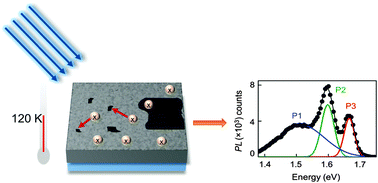Low temperature excitonic spectroscopy and dynamics as a probe of quality in hybrid perovskite thin films†
Abstract
We have developed a framework for using temperature dependent static and dynamic photoluminescence (PL) of hybrid organic–inorganic perovskites (PVSKs) to characterize lattice defects in thin films, based on the presence of nanodomains at low temperature. Our high-stability PVSK films are fabricated using a novel continuous liquid interface propagation technique, and in the tetragonal phase (T > 120 K), they exhibit bi-exponential recombination from free charge carriers with an average PL lifetime of ∼200 ns. Below 120 K, the emergence of the orthorhombic phase is accompanied by a reduction in lifetimes by an order of magnitude, which we establish to be the result of a crossover from free carrier to exciton-dominated radiative recombination. Analysis of the PL as a function of excitation power at different temperatures provides direct evidence that the exciton binding energy is different in the two phases, and using these results, we present a theoretical approach to estimate this variable binding energy. Our findings explain this anomalous low temperature behavior for the first time, attributing it to an inherent fundamental property of the hybrid PVSKs that can be used as an effective probe of thin film quality.


 Please wait while we load your content...
Please wait while we load your content...